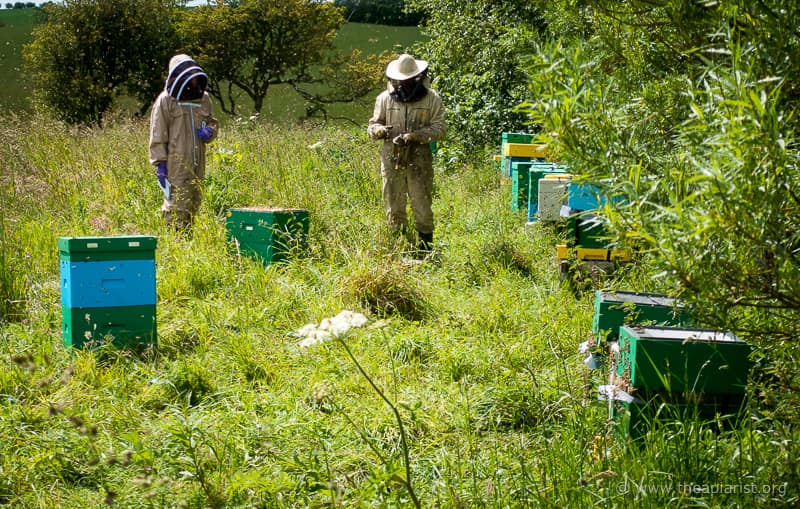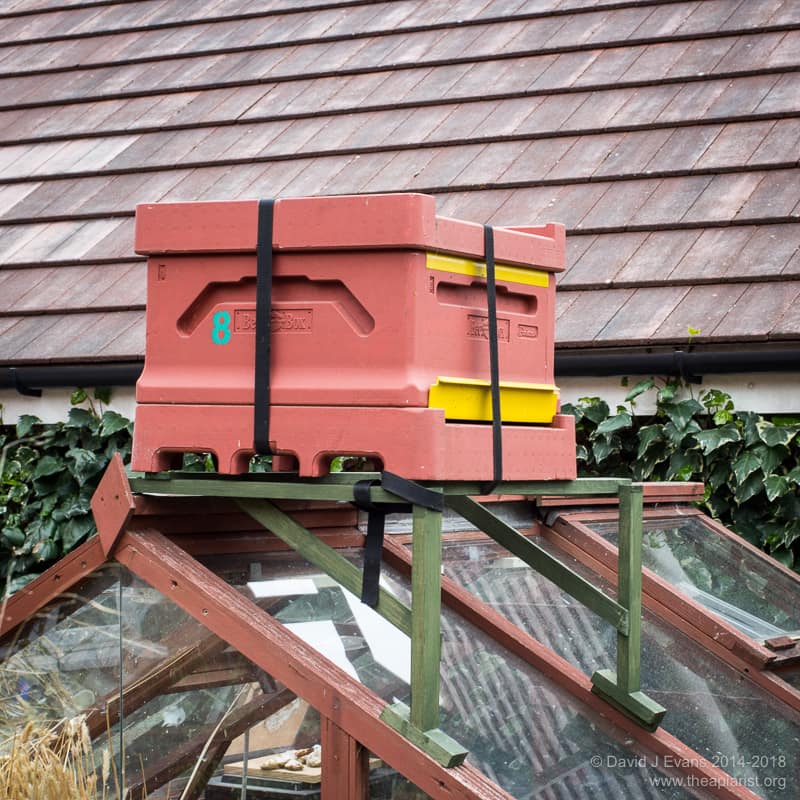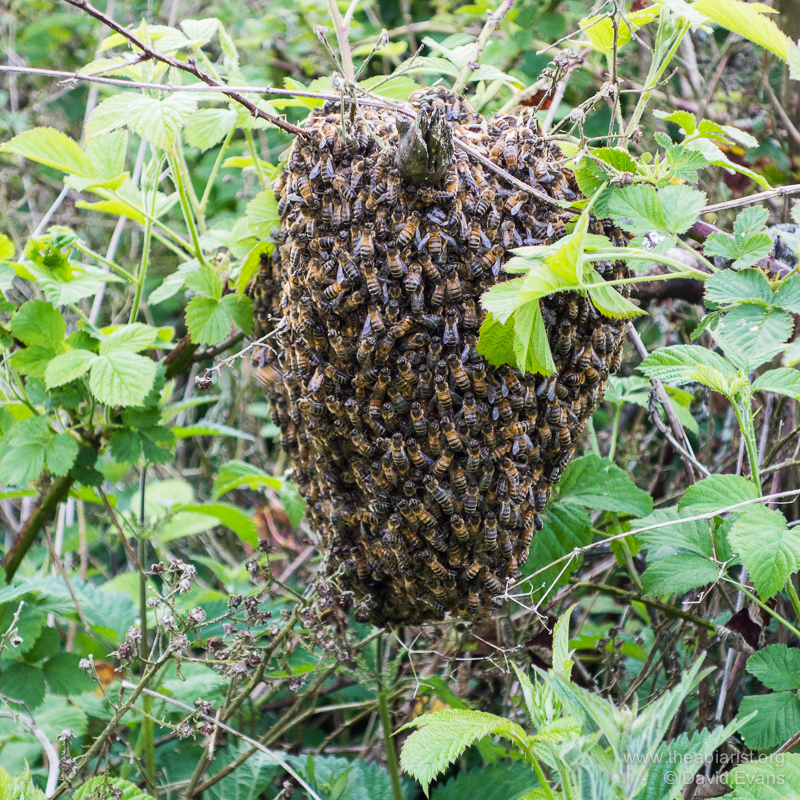Darwinian beekeeping
A fortnight ago I reviewed the first ten chapters of Thomas Seeley’s recent book The Lives of Bees. This is an excellent account of how honey bees survive in ‘the wild’ i.e. without help or intervention from beekeepers.
Seeley demonstrates an all-too-rare rare combination of good experimental science with exemplary communication skills.
It’s a book non-beekeepers could appreciate and in which beekeepers will find a wealth of entertaining and informative observations about their bees.
The final chapter, ‘Darwinian beekeeping’, includes an outline of practical beekeeping advice based around what Seeley (and others) understand about how colonies survive in the wild.
Differences
The chapter starts with a very brief review of about twenty differences between wild-living and managed colonies. These differences have already been introduced in the preceding chapters and so are just reiterated here to set the scene for what follows.
The differences defined by Seeley as distinguishing ‘wild’ and ‘beekeepers’ colonies cover everything from placement in the wider landscape (forage, insecticides), the immediate environment of the nest (volume, insulation), the management of the colony (none, invasive) and the parasites and pathogens to which the bees are exposed.
Some of the differences identified are somewhat contrived. For example, ‘wild’ colonies are defined fixed in a single location, whereas managed colonies may be moved to exploit alternative forage.
In reality I suspect the majority of beekeepers do not move their colonies. Whether this is right or not, Seeley presents moving colonies as a negative. He qualifies this with studies which showed reduced nectar gathering by colonies that are moved, presumably due to the bees having to learn about their new location.
However, the main reason beekeepers move colonies is to exploit abundant sources of nectar. Likewise, a static ‘wild’ colony may have to find alternative forage when a particularly good local source dries up.
If moving colonies to exploit a rich nectar source did not usually lead to increased nectar gathering it would be a pretty futile exercise.
Real differences
Of course, some of the differences are very real.
Beekeepers site colonies close together to facilitate their management. In contrast, wild colonies are naturally hundreds of metres apart {{1}}. I’ve previously discussed the influence of colony separation and pathogen transmission {{2}}; it’s clear that widely spaced colonies are less susceptible to drifting and robbing from adjacent hives, both processes being associated with mite and virus acquisition {{3}}.
The other very obvious difference is that wild colonies are not treated with miticides but managed colonies (generally) are. As a consequence – Seeley contends – beekeepers have interfered with the ‘arms race’ between the host and its parasites and pathogens. Effectively beekeepers have ‘weaken[ed] the natural selection for disease resistance’.
Whilst I don’t necessarily disagree with this general statement, I am not convinced that simply letting natural selection run its (usually rather brutal) course is a rational strategy.
But I’m getting ahead of myself … what is Darwinian beekeeping?
Darwinian beekeeping
Evolution is probably the most powerful force in nature. It has created all of the fantastic wealth of life forms on earth – from the tiniest viroid to to the largest living thing, Armillaria ostoyae {{4}}. The general principles of Darwinian evolution are exquisitely simple – individuals of a species are not identical; traits are passed from generation to generation; more offspring are born than can survive; and only the survivors of the competition for resources will reproduce.
I emphasised ‘survivors of the competition’ as it’s particularly relevant to what is to follow. In terms of hosts and pathogens, you could extend this competition to include whether the host survives the pathogen (and so reproduces) or whether the pathogen replicates and spreads, but in doing so kills the host.
Remember that evolution is unpredictable and essentially directionless … we don’t know what it is likely to produce next.
Seeley doesn’t provide a precise definition of Darwinian beekeeping (which he also terms natural, apicentric or beefriendly beekeeping). However, it’s basically the management of colonies in a manner that more closely resembles how colonies live in the wild.
In doing so, he claims that colonies will have ‘less stressful and therefore more healthful’ lives.
I’ll come back to this point at the end. It’s an important one. But first, what does Darwinian mean in terms of practical beekeeping?
Practical Darwinian beekeeping
Having highlighted the differences between wild and managed colonies you won’t be surprised to learn that Darwinian beekeeping means some {{5}} or all of the following: {{6}}
- Keep locally adapted bees – eminently sensible and for which there is increasing evidence of the benefits.
- Space colonies widely (30-50+ metres) – which presumably causes urban beekeepers significant problems.
- Site colonies in an area with good natural forage that is not chemically treated – see above.
- Use small hives with just one brood box and one super – although not explained, this will encourage swarming.
- Consider locating hives high off the ground – in fairness Seeley doesn’t push this one strongly, but I could imagine beekeepers being considered for a Darwin Award if sufficient care wasn’t taken.
- Allow lots of drone brood – this occurs naturally when using foundationless frames.
- Use splits and the emergency queen response for queen rearing i.e. allow the colony to choose larvae for the preparation of new queens – I’ve discussed splits several times and have recently posted on the interesting observation that colonies choose very rare patrilines for queens.
- Refrain from treating with miticides – this is the biggy. Do not treat colonies. Instead kill any colonies with very high mite levels to prevent them infesting other nearby colonies as they collapse and are robbed out.
Good and not so good advice
A lot of what Seeley recommends is very sound advice. Again, I’m not going to paraphrase his hard work – you should buy the book and make your own mind up.
Sourcing local bees, using splits to make increase, housing bees in well insulated hives etc. all works very well.
Some of the advice is probably impractical, like the siting of hives 50 metres apart. A full round of inspections in my research apiary already takes a long time without having to walk a kilometre to the furthest hive.
The prospect of inspecting hives situated at altitude is also not appealing. Negotiating stairs with heavy supers is bad enough. In my travels I’ve met beekeepers keeping hives on shed roofs, accessed by a wobbly step ladder. An accident waiting to happen?
And finally, I think the advice to use small hives and to cull mite-infested colonies is poor. I understand the logic behind both suggestions but, for different reasons, think they are likely to be to the significant detriment of bees, bee health and beekeeping.
Let’s deal with them individually.
Small hives – one brood and one super
When colonies run out of space for the queen to lay they are likely to swarm. The Darwinian beekeeping proposed by Seeley appears to exclude any form of swarm prevention strategy. Hive manipulation is minimal and queens are not clipped.
They’ll run out of space and swarm.
Even my darkest, least prolific colonies need more space than the ~60 litres offered by a brood and super.
Seeley doesn’t actually say ‘allow them to swarm’, but it’s an inevitability of the management and space available. Of course, the reason he encourages it is (partly – there are other reasons) to shed the 35% of mites and to give an enforced brood break to the original colony as it requeens.
These are untreated colonies. At least when starting the selection strategy implicit in Darwinian beekeeping these are likely to have a very significant level of mite infestation.
These mites, when the colony swarms, disappear over the fence with the swarm. If the swarm survives long enough to establish a new nest it will potentially act as a source of mites far and wide (through drifting and robbing, and possibly – though it’s unlikely as it will probably die – when it subsequently swarms).
Thanks a lot!
Lost swarms – and the assumption is that many are ‘lost’ – choose all sorts of awkward locations to establish a new nest site. Sure, some may end up in hollow trees, but many cause a nuisance to non-beekeepers and additional work for the beekeepers asked to recover them.
In my view allowing uncontrolled swarming of untreated colonies is irresponsible. It is to the detriment of the health of bees locally and to beekeepers and beekeeping.
Kill heavily mite infested colonies
How many beekeepers reading this have deliberately killed an entire colony? Probably not many. It’s a distressing thing to have to do for anyone who cares about bees.
The logic behind the suggestion goes like this. The colony is heavily mite infested because it has not developed resistance (or tolerance). If it is allowed to collapse it will be robbed out by neighbouring colonies, spreading the mites far and wide. Therefore, tough love is needed. Time for the petrol, soapy water, insecticide or whatever your choice of colony culling treatment.
In fairness to Seeley he also suggests that you could requeen with known mite-resistant/tolerant stock.
But most beekeepers tempted by Darwinian ‘treatment free’ natural beekeeping will not have a queen bank stuffed with known mite-resistant mated queens ‘ready to go’.
But they also won’t have the ‘courage’ to kill the colony.
They’ll procrastinate, they’ll prevaricate.
Eventually they’ll either decide that shaking the colony out is OK and a ‘kinder thing to do’ … or the colony will get robbed out before they act and carpet bomb every strong colony for a mile around.
Killing the colony, shaking it out or letting it get robbed out have the same overall impact on the mite-infested colony, but only slaying them prevents the mites from being spread far and wide.
And, believe me, killing a colony is a distressing thing to do if you care about bees.
In my view beefriendly beekeeping should not involve slaughtering the colony.
Less stress and better health
This is the goal of Darwinian beekeeping. It is a direct quote from final chapter of the book (pp286).
The suggestion is that unnatural beekeeping – swarm prevention and control, mite management, harvesting honey (or beekeeping as some people call it 😉 ) – stresses the bees.
And that this stress is detrimental for the health of the bees.
I’m not sure there’s any evidence that this is the case.
How do we measure stress in bees? Actually, there are suggested ways to measure stress in bees, but I’m not sure anyone has systematically developed these experimentally and compared the stress levels of wild-living and managed colonies.
I’ll explore this topic a bit more in the future.
I do know how to measure bee health … at least in terms of the parasites and pathogens they carry. I also know that there have been comparative studies of managed and feral colonies.
Unsurprisingly for an unapologetic unnatural beekeeper like me ( 😉 ), the feral colonies had higher levels of parasites and pathogens (Catherine Thompson’s PhD thesis [PDF] and Thompson et al., 2014 Parasite Pressures on Feral Honey Bees). By any measurable definition these feral colonies were less healthy.
Less stress and better health sounds good, but I’m not actually sure it’s particularly meaningful.
I’ll wrap up with two closing thoughts.
One of the characteristics of a healthy and unstressed population is that it is numerous, productive and reproduces well. These are all characteristics of strong and well-managed colonies.
Finally, persistently elevated levels of pathogens are detrimental to the individual and the population. It’s one of the reasons we vaccinate … which will be a big part of the post next week.
{{1}}: Though this must at least partially be due to suitable nest site availability. I’m not aware that this has been studied.
{{2}}: Though I appear not to have posted anything on related work by Seeley and Smith … an omission I’ll correct sometime in the future
{{3}}: And brood diseases such as the foulbroods.
{{4}}: Not the blue whale. Armillaria ostoyae is the Humungous Fungus. This is a type of honey fungus that grows in the Blue Mountains of Oregon where a single ‘individual’ (defined by genetic identity) has been measured as covering almost four square miles and was aged at between 1900 and 8600 years old.
{{5}}: I say some as Seeley makes clear that what he proposes is a recipe in which not all of the ingredients are necessarily selected.
{{6}}: I’m not going to list everything (buy the book, you won’t regret it) but I will highlight a few and add comments (in italics) of my own.




Join the discussion ...